
I know, I know, that isn’t very good… Please forgive the attempt to bring to mind some of the most famous verses there are about Spring:
When April with his showers sweet with fruit
The drought of March has pierced unto the root …
And many little birds make melody
That sleep through all the night with open eye
(So Nature pricks them on to ramp and rage)
Then do folk long to go on pilgrimage …

Pilgrims on the road to Canterbury, from John Lydgate’s Prologue of the Siege of Thebes, London, c. 1457–1460: Royal MS 18 D II, f. 148.
These verses are quoted often this time of year. I’m writing this in Boston, and they are a pretty apt description of what April is like here. It is a very pleasant month. I suspect many of our readers (maybe all of our readers in fact) know that these words, albeit translated into modern English, are from the General Prologue to Chaucer’s Canterbury Tales (you can read the whole prologue in Chaucer’s original language and in a modern translation here).

Spring … April … singing (birds) … and pilgrimage - the urge to get up and go – what do all these remind me of? This April, Chaucer’s words seem to resonate with a number of the manuscripts in the Spring Update of our TM site. And not because we have a Chaucer manuscript for sale; keep reading to find out why.

Our original offering of 29 manuscripts, announced April 4th, included a remarkable number of music manuscripts – nine all told. (As I write this, quite a few of the manuscripts in the new list have already been snatched up by eager buyers, so many are already sold and now in our Archives).
What do you think of when you think of medieval music? Maybe a huge Choir Book like this one?
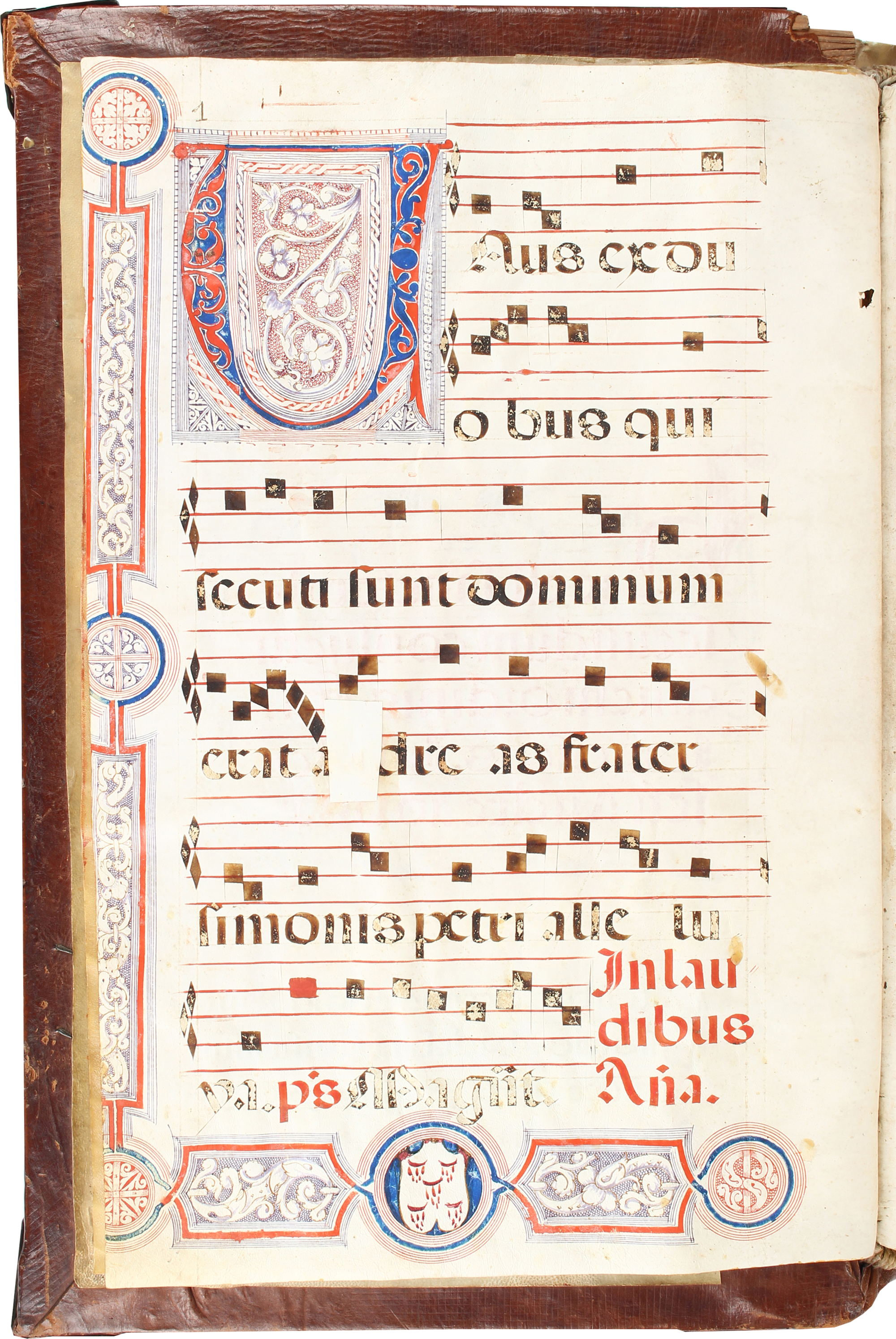
TM 954, Antiphonal, Seville, 1572, with additions dated 1662 and 1798, f. 1
Very large music manuscripts (our Antiphonal from Seville measures 484 x 318 mm. or about 19 x 12 ½ inches, and it is a massive, and very heavy volume) were copied beginning in the fifteenth century; they continued to be made for centuries after the invention of printing, certainly into the eighteenth century. They were big enough so that the entire choir could sing from a single book, as shown in the remarkable image.
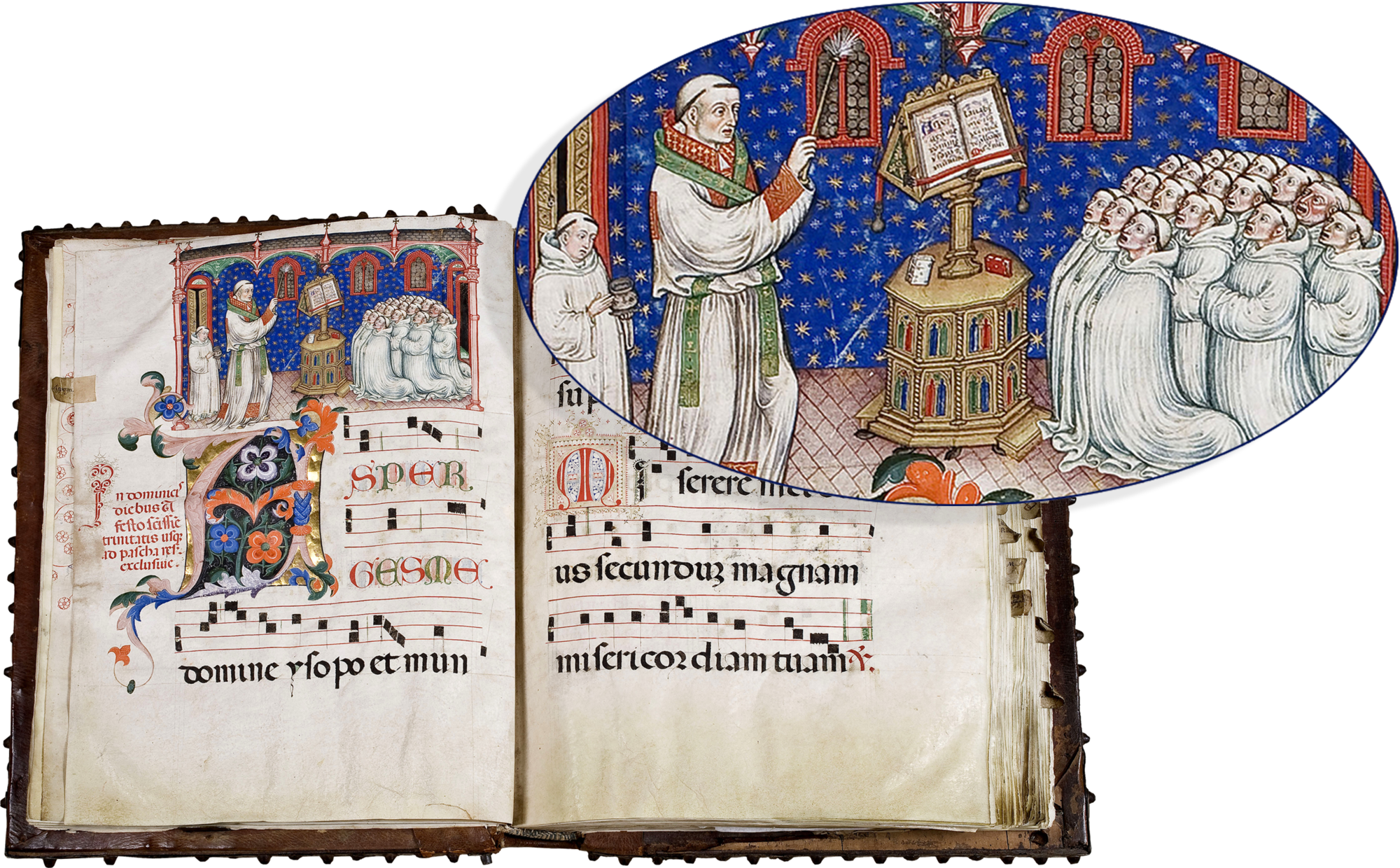
Olivetan Gradual, formerly Les Enluminures, now New Haven, Yale University, Beinecke Library, MS 1184
Antiphonals were volumes with the text and music sung by the choir during the Divine Office; Graduals included the sung texts, with the words, for the Mass. Many of these massive volumes now survive, sadly, only as single leaves or as cuttings. To really understand what these books were like and how they were used, you absolutely need to see a complete manuscript (or to sing from one; there is no substitute for that experience!).
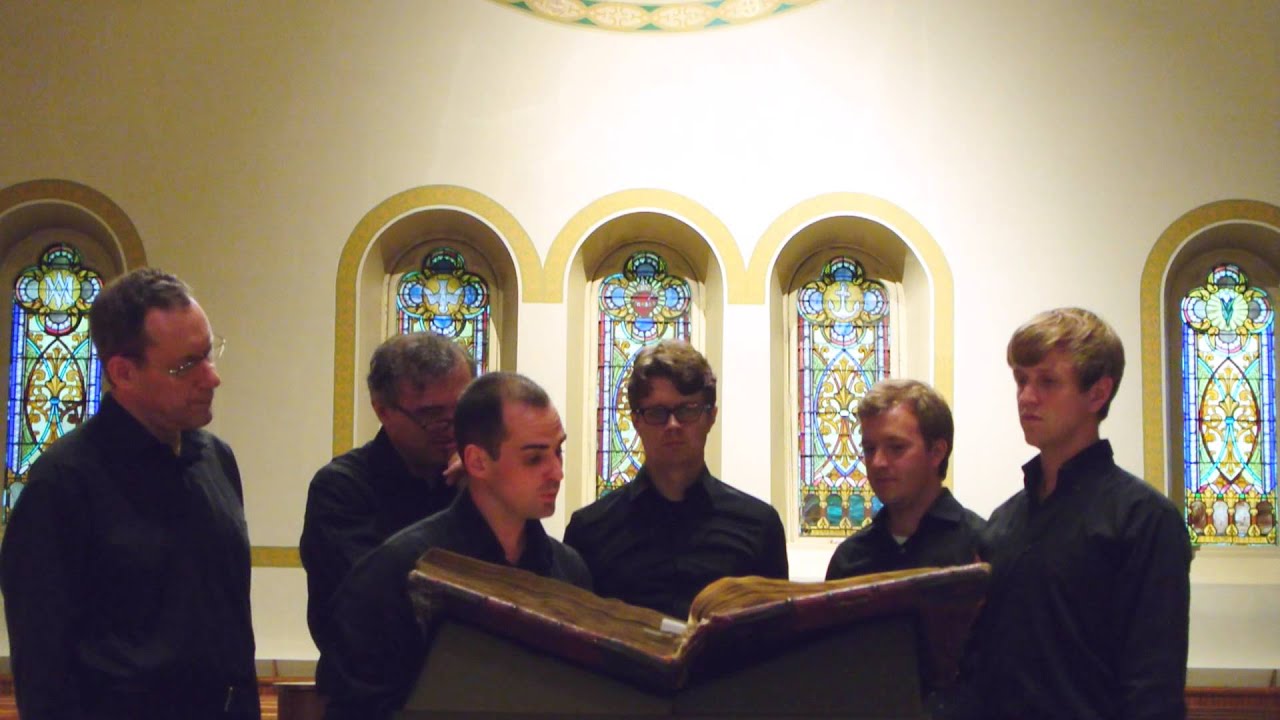
"Singing the Antiphonary,” an Online Exhibition curated by Pablo Alvarez, Outreach Librarian and Curator, Special Collections Library, University of Michigan Library.
Our Spanish Antiphonal, TM 954 is particularly interesting since it includes a note by the scribe, Alonso Ruiz, who states he copied it in 1572 for the abbess, Catalina de Ribera, who was almost certainly from the same family as the famous Catalina de Ribera (d. 1505), patron of the arts, whose name lives on in the streets and gardens of Seville.
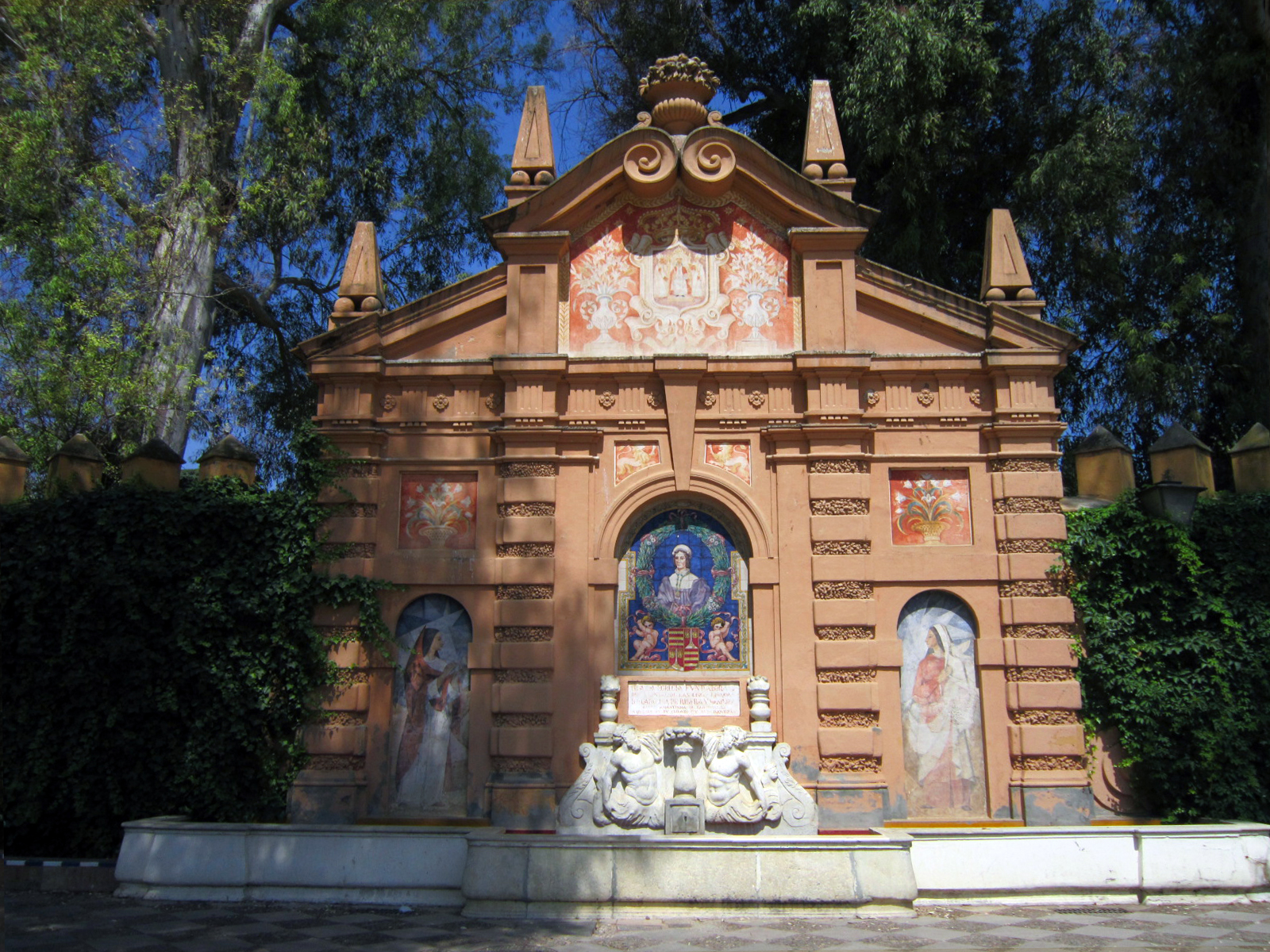
Tomb of Catalina de Ribera, Seville, Spain.
It also includes a very long note dated 1798, describing how it was updated and re-bound. This is fascinating evidence for how long it was in active use. It is bound in massive wooden boards covered with leather, armored, as was customary, with metal fittings. Its beautiful bookmark, made of metal and ribbons, still survives in the volume.
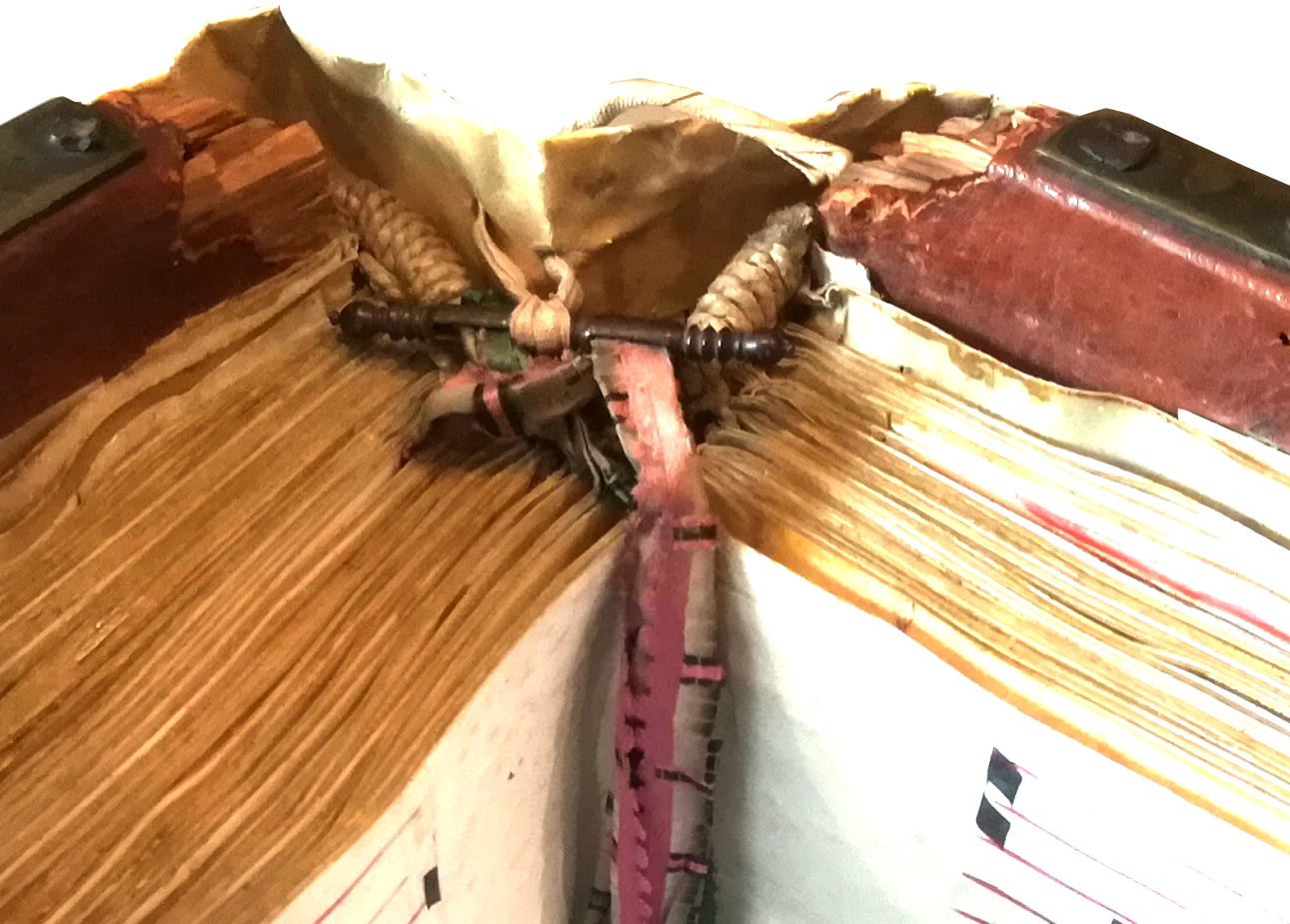
Bookmark in TM 954, Antiphonal, Seville, 1572, with additions dated 1662 and 1798.
But famous and interesting as they are, giant Choir Book were not the only music manuscripts copied for use in churches in the Middle Ages and the Renaissance. And I wasn’t thinking of these eminently non-portable books, when thoughts of April and Chaucer’s pilgrims entered my mind. I was in fact thinking of the medieval music manuscripts we call Processionals.
Processionals are likely the most important type of liturgical manuscript many of you have never heard of. (Although attentive readers of this blog may remember an earlier post on Spanish Processionals now at the University of Sydney.) As their name indicates, Processionals are liturgical books containing the music and prayers for liturgical processions. Designed to be carried, they were usually small and portable.
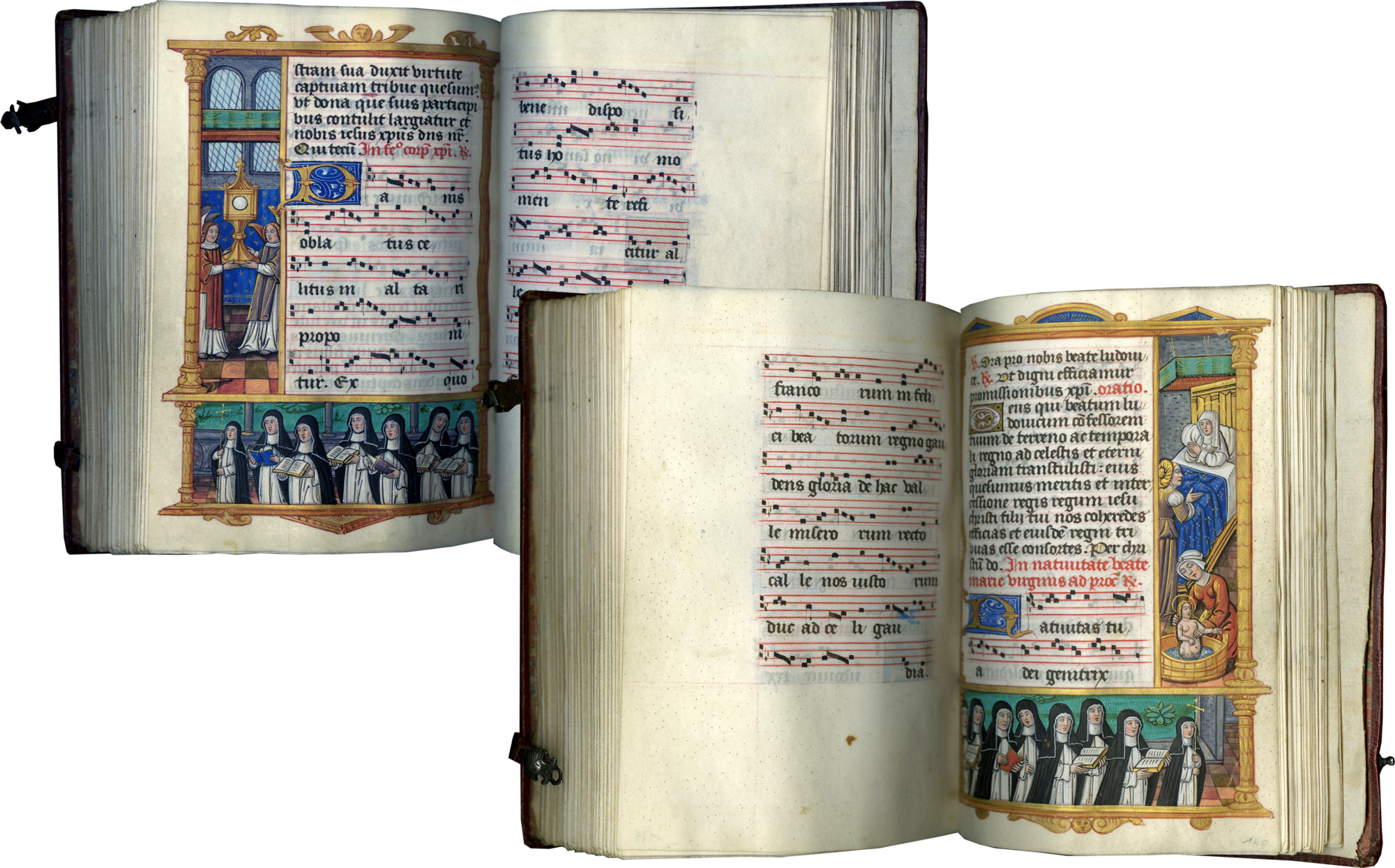
Dominican nuns carrying their Processionals at the Royal Abbey of Poissy. TM 1019, Processional, France (Paris), c. 1505-1515, ff.119v-120 and ff. 139v-140
Processions were an important part of the liturgy during the Middle Ages and into the early modern era in both secular churches and within religious orders. Processions, for example, preceded the celebration of the Mass on each Sunday, were an important part of the liturgical observances on saints’s days and on other important liturgical occasions, and were assembled in times of need, to ask for rain, avert famine, or in the face of other catastrophic events. The Palm Sunday procession reenacting Christ’s entry into Jerusalem is a notable example that is still celebrated today. Rites of death and burial were also accompanied by processions.
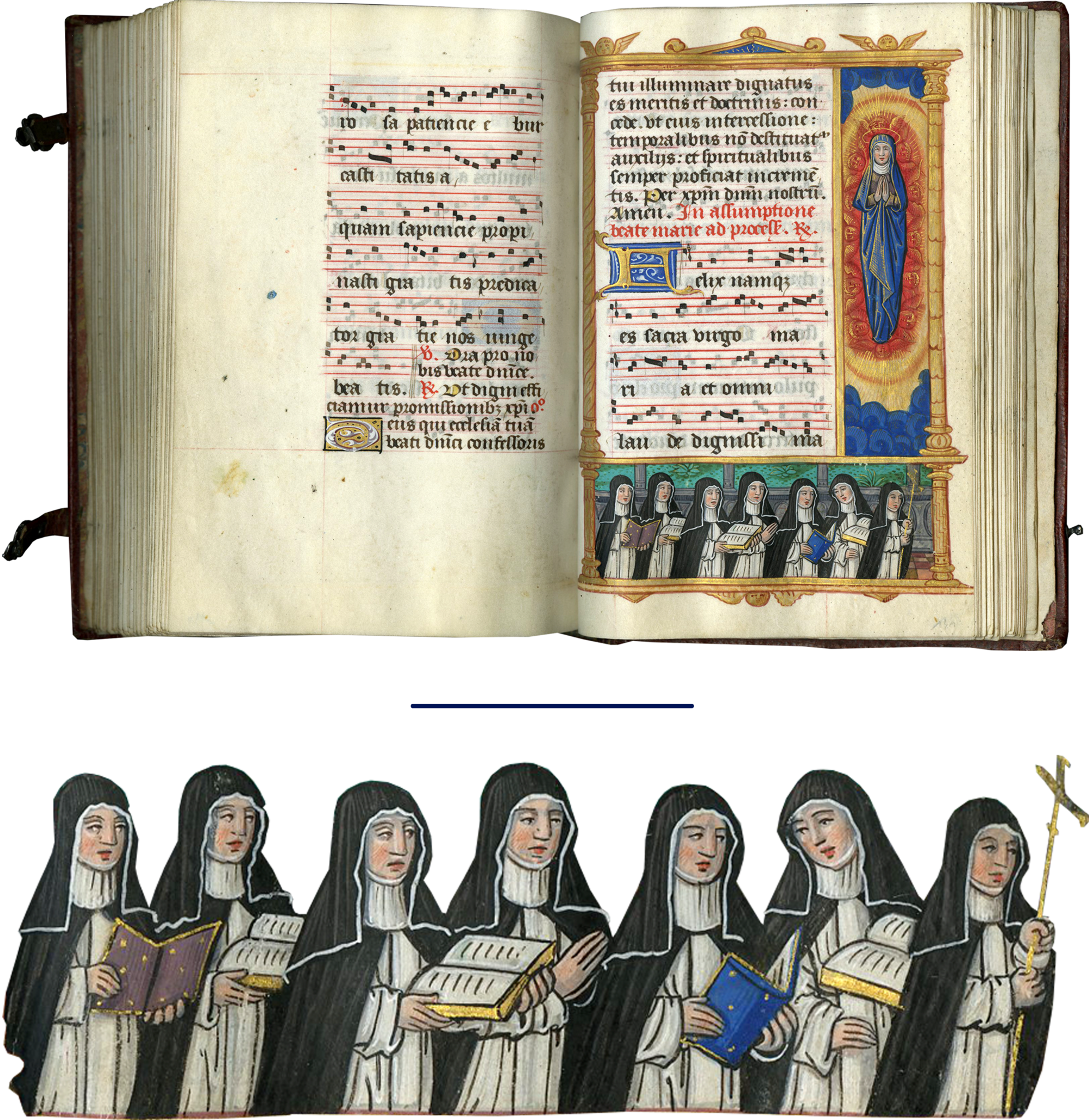
A Procession for the feast of the Assumption at the Royal Abbey of Poissy. The cloister is visible in the background. TM 1019, Processional, France (Paris), c. 1505-1515, ff. 130v-131.
Processionals, in short, were books you carried with you. Like pilgrimages, which were certainly religious activities, but which also seem to have been at times somewhat recreational, liturgical processions were both serious parts of the liturgy and entertainment for lay people, for clerics, and, perhaps especially, for monks and nuns. Some processions went around the monastic cloister (or just from altar to altar within a church); but others went from church to church through the streets of cities and towns, and even into the surrounding fields. I’m sure everyone involved loved the opportunity to get up and move, and to go outside (at least in the spring).
Many surviving Processionals from the late Middle Ages were made for nuns. Some of the most famous examples were lovely, personal volumes, likely made for a woman entering the religious life, or perhaps to celebrate her solemn vows. Our update includes three illuminated Processionals, all made for nuns: TM 1019, made for a Dominican nun at the Royal Abbey of Poissy (shown above); TM 1031, made for the Dominican nuns of St. Matthew in Rouen, also a royal foundation
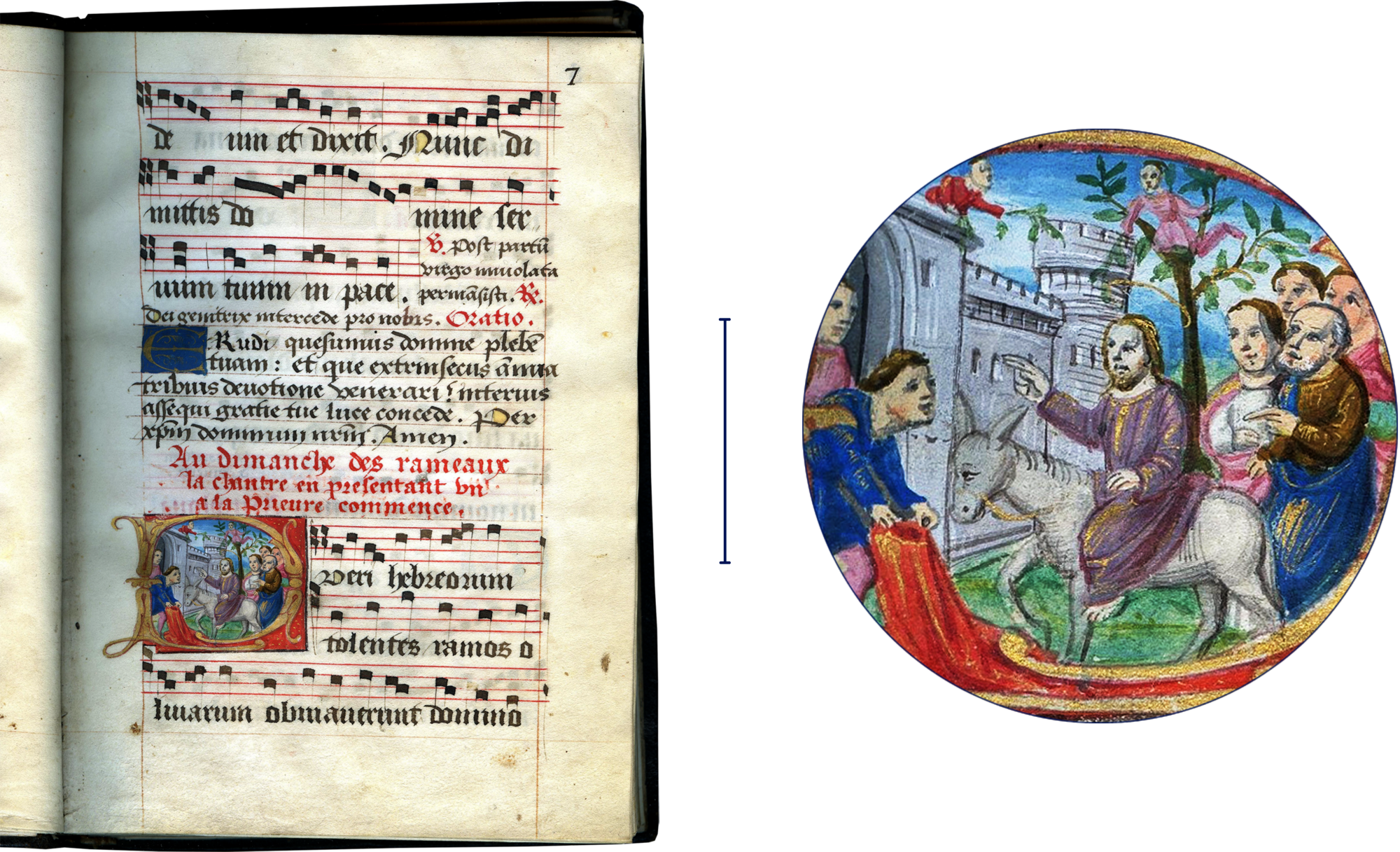
Medieval processions reenacted Christ’s entry into Jerusalem every Palm Sunday, as shown in this Processional from a convent of Dominican nuns in Rouen. TM 1031, Processional, France (Rouen), c. 1520-1530, c. 1525-1550, 1674.
and TM 990, a Processional from Nonnberg Abbey in Salzburg, the oldest convent in the German-speaking world, which will forever live in popular culture as Maria’s convent in the “Sound of Music.” This Processional includes a portrait of its first owner, who may have also been the scribe and illuminator, Margaret Marckdorff, who was a nun at the abbey. Named female scribes and artists are much, much less common than their male counterparts.
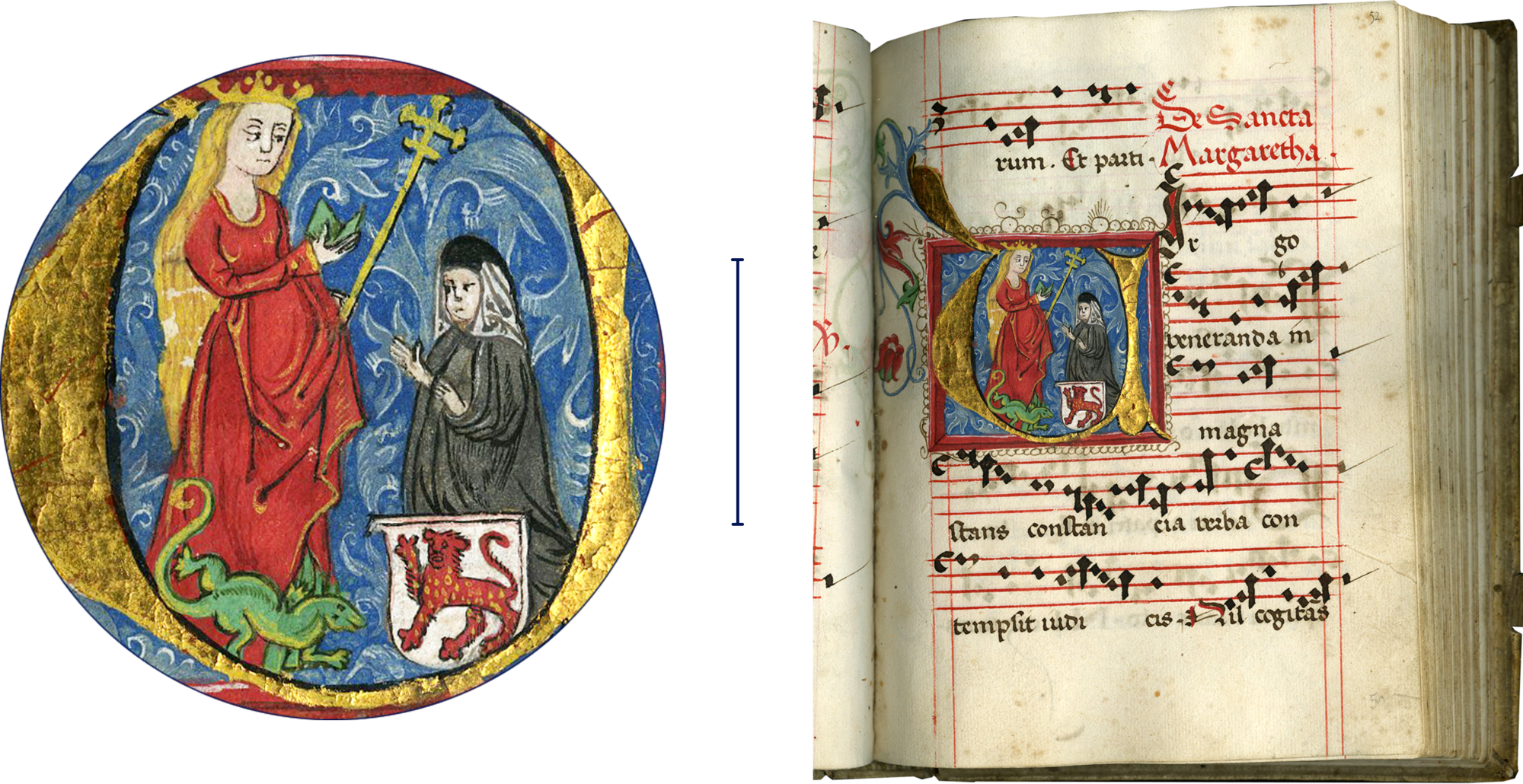
Margaret Marckdorff, the first owner, and possibly the scribe and illuminator of this Processional, with her family arms next to her, kneeling before St. Margaret. TM 990, Processional of Nonnberg Abbey, Austria (Salzburg), c. 1505-1515.
Pictures in the case of these manuscripts, although certainly better than just words, don’t tell the whole story. You can listen to students at Bryn Mawr College sing chants for Candlemas from their Possy Processional here and on YouTube.
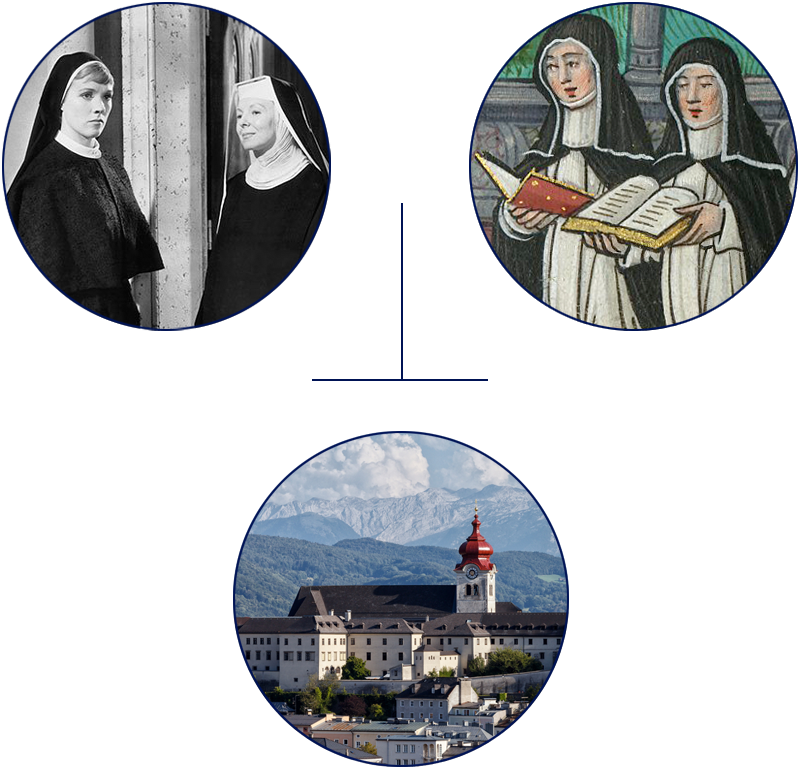
Maria and the Mother Superior in the Sound of Music; Nonnberg Abbey, Salzburg, Austria.
You can now receive periodic blog post updates by submitting your email up above in “Follow Us.”


